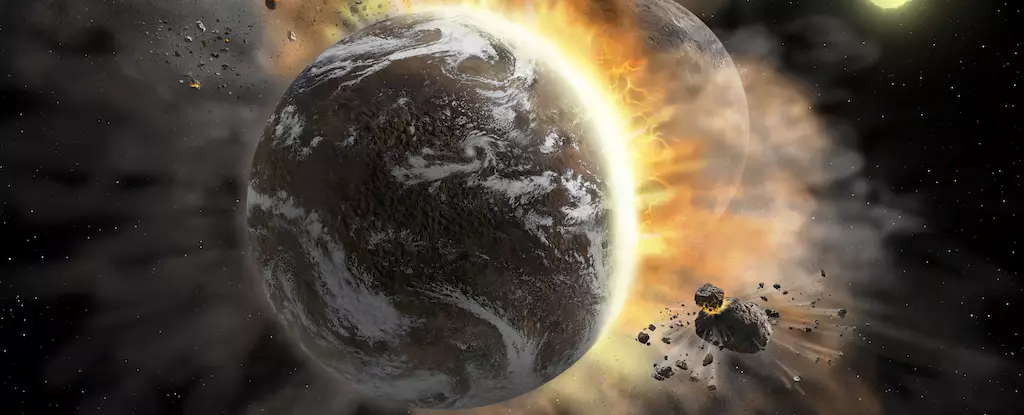The study of celestial bodies often leads us to confront the tumultuous history of the early Solar System, a time when the cosmos was not the serene expanse we experience today. Our Moon, riddled with craters, serves as a compelling testament to a violent past filled with collisions and chaos. This scenario of an early debris field, littered with remnants of planetary formation, compels us to explore how similar processes might inform our understanding of exoplanets in distant systems.
Recent research sheds new light on these phenomena, specifically investigating the merger of colossal planets and the resultant seismic activities arising from such cataclysmic events. The implications of these studies extend far beyond mere academic interest; they point to revolutionary methods of detecting and understanding distant worlds.
Collisions: The Genesis of Mega-Planets
The nature of giant planets and their formation has long intrigued astrophysicists. It is theorized that the cores of some massive exoplanets may contain over 100 Earth masses of solid material, indicative of their violent birth process. The merging of smaller planetary cores—each contributing approximately 10 Earth masses—plays a crucial role in this cosmic assembly line. This merging phenomenon mirrors the fundamental processes that sculpted our own Solar System and has staggering implications for the composition and characteristics of distant exoplanets.
A recent investigation led by J.J. Zanazzi from UC Berkeley dives into this captivating subject by simulating the impact of a younger gas giant colliding with a more established counterpart. This collision isn’t merely a spectacle of destruction; it may generate seismic waves that carry insight into the planetary interiors. These seismic activities, if detectable, could provide glimpses into the hidden layers of exoplanets, fundamentally changing our approach to exoplanet research and characterization.
Seismic Waves as Messengers of Change
Central to the research is the question of whether giant planet collisions produce seismic waves potent enough to endure and be detected by observatories like the James Webb Space Telescope (JWST). While the JWST operates chiefly by analyzing light, small changes in luminosity due to seismic waves can serve as indirect indicators of seismic activity. This groundbreaking perspective could transform how we study exoplanets, marrying seismology with modern astrophysics.
Zanazzi’s team focused on the exoplanet Beta Pictoris b, a young super-Jupiter characterized by its significant metal content, ranging from 100 to 300 Earth masses. Its relatively young age of 12 to 20 million years positions it as an ideal candidate for studying the effects of giant impacts. The evidence gathered from such collisions and the seismic waves they create could amplify our understanding of planetary formation and evolution, with implications for both nearby and alien worlds.
New Frontiers in Exoplanet Exploration
The researchers’ findings indicate that if a collision between a Neptune-mass planet and Beta Pictoris b occurred within the last 9 to 18 million years, the resulting seismic waves would induce observable changes in the planet’s luminosity. This discovery paves the way for new observational techniques that allow for the probing of exoplanetary interiors without the need for direct access.
By using seismic data to draw inferences about a planet’s internal structure, astronomers may unlock mysteries related to bulk density and stable stratification regions within these gas giants. Such insights have traditionally been gleaned through gravity measurements, which often lack precision when applied to distant planets. The innovative approach presented here signifies a remarkable leap in our ability to study the unseen dynamics within exoplanets.
Beyond Collisions: Understanding Planetary Migration
Interestingly, the research does not limit itself to collisions. The authors propose that oscillations in giant planets could also arise from high eccentricity migrations, a process influenced by tidal gravitational forces from their host stars. The potential for detection via JWST raises exciting possibilities for interpreting the infrared light curves of eccentric massive planets, expanding our grasp of how celestial mechanics shapes the architecture of distant solar systems.
As we unravel the complexities of planetary formation and migration, the coupling of seismic wave analysis with observational astrophysics offers a rich tapestry of research possibilities. This multidimensional approach might soon reveal new, profound findings about the nature of planets beyond our own.
The implications of these studies resonate through the astronomical community, inviting a deeper exploration of the grand cosmic symphony that unfolds across the universe. Each discovery adds a note to our collective understanding of how we fit into the cosmic landscape—an intricate web influenced by chaos, creation, and the constant dance of celestial bodies.


Leave a Reply